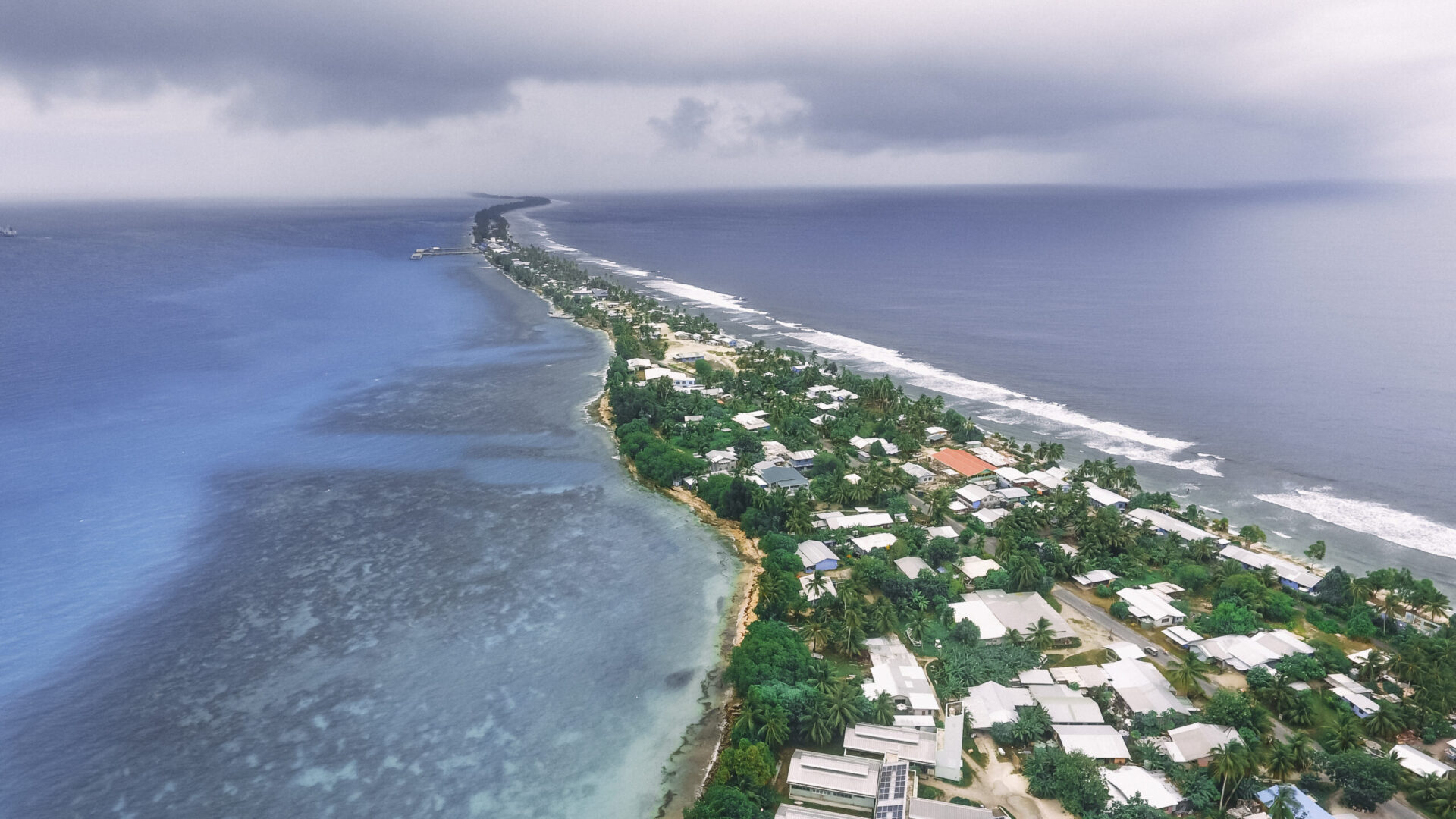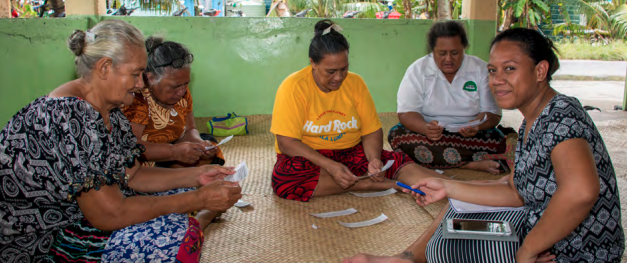How Integrated Vulnerability Assessments Support NAP Processes in the Pacific Region

Introduction
Pacific Islanders are among the world’s most at risk to climate change, while at the same time being among those least responsible for its cause. More intense cyclones, droughts, coastal inundation and rising sea levels are contributing to land loss and having a negative impact on the livelihoods, food and water security of communities living in low-lying coastal areas. These changes threaten the overall habitability of countries like Kiribati and Tuvalu, among others.
To adapt to these challenges, many Pacific island countries are engaged in National Adaptation Plan (NAP) processes. Several Pacific island countries have chosen to use integrated (multisector) vulnerability assessments (IVAs) to capture and incorporate community-level vulnerability information into their NAP processes. The IVA Framework was developed in 2016 by Pacific organizations in response to a perceived need to support a standardized, coordinated and integrated approach to assessing climate vulnerability in the region. As it provides baseline data about communities’ vulnerability through a standardized approach that can be periodically replicated, IVA can be a valuable tool to inform the development, implementation, and monitoring and evaluation of NAP processes.
This briefing note* highlights the significance of the IVA Framework to the NAP processes underway in three Pacific island states: Kiribati, Tuvalu and the Solomon Islands.
* Download the full text (see right-hand column) for more detail and recommendations for IVA. A short overview of the briefing note is provided below.
The IVA Framework
The IVA process systematically collects and collates vulnerability data from multiple perspectives, sectors and scales related to each of these categories. This data is then used to determine the impacts of climate change on livelihood assets and how they affect the ability of communities to address human security needs over time. These human security needs, or human security objectives, include: security of place, community health, ecosystem health, water security, food security, income security and energy security at a particular point in time.
The IVA process helps answer questions such as:
- What human security hardships are local communities facing and experiencing?
- What causes those hardships?
- What has and is being done to address these hardships?
- How effective have past response interventions been?
- How can these interventions be improved?
- How will climate change affect these human security challenges in the future
These questions are answered from the perspective of local women, men and youth via the use of participatory field tools. Technical and scientific perspectives are also provided via sector stakeholder consultations and the review of existing secondary data sources from multiple disciplines, scales and sector-based analyses.
The IVA process is distinctive from other vulnerability assessments because it brings together two key elements for informing adaptation planning: (i) a common overarching national framework for analyzing and developing vulnerability baselines and (ii) a means of monitoring and evaluating adaptation outcomes that can be used as a common point of reference for communities, policy-makers, implementers and researchers. It is also advantageous because it incorporates the use of multiple sources of existing and relevant data with varied methodologies (qualitative, quantitative, subjective, objective) and methods (surveys, geographic information systems [GIS] and satellite imagery, documentation review). The IVA process is also sourced from multiple sectors (agriculture, health, coastal management) at multiple scales (community, island, national) and times. IVA is designed to be a simple process that creates a common point of reference of analysis for communities, adaptation practitioners and researchers.
Applying the IVA in Three Pacific Countries
The NAP Global Network has delivered technical assistance on the NAP process in more than 30 countries. In 2017-18, the NAP Global Network worked with three Pacific countries—Kiribati, Tuvalu, Fiji and the Solomon Islands—to support their respective NAP processes with financial support from the Government of Canada. This support included the application of the IVA Framework in Kiribati, Tuvalu, and the Solomon Islands. See the full text for details of how NAP Global Network supported IVA processes in these countries.
Key Messages (in brief)
- Application of the IVA Framework and establishment of a national IVA database provides a means of incorporating climate and disaster data from multiple sources of knowledge, methods and scales of analysis. In each of the three cases mentioned, the IVA Framework became and continues to be a valuable tool in both informing and influencing national- and community-level adaptation planning.
- The IVA process requires unprecedented levels of data generation, organization and sharing in the three countries and in the Pacific region as a whole. As such, more dialogue and agreements about IKM protocols are required between national stakeholders and international partners to facilitate critical knowledge flows that will enable more systematic, robust and country-owned NAP processes.
- A national IVA Framework that includes a system for primary and secondary data collection, systematized consolidation of information in a database for documentation and analysis, and standardized reporting forms can be instrumental in institutionalizing national-level vulnerability and adaptation knowledge management systems.
- Such an IKM system for climate and disaster vulnerability can enable formal linking and institutionalization of the IVA and NAP processes. This step will require further human resources, institutional capacity development, alignment between national planning and budgeting, and key sector and community support from service-oriented government ministries and non-governmental organizations.
- An IVA knowledge management system of this type is essential to inform NAP prioritization, planning, and monitoring and evaluation processes in a sector-integrated, iterative and timely manner and at multiple levels of adaptation decision making. It helps to:
- Inform climate vulnerability baseline situations for various localities using a standardized, context-sensitive and comparable method.
- Develop baseline situations and influence how discussions about “shifting baselines” in changing environments could be approached.
- Identify which communities and individuals may be considered to be particularly vulnerable to climate change.
- Inform how adaptation planning can better incorporate gender equity and social inclusivity considerations.
- Identify sectoral-, subnational- and national-level adaptation priorities for NAP process planning, implementation, and monitoring and evaluation.
- Provide the evidence base to inform investment strategies
- Linking the IVA to the NAP process in such a knowledge-based way has the potential to facilitate a paradigm shift toward climate-resilient sustainable development by:
- Identifying and responding proactively to people and places that are particularly vulnerable to climate change.
- Institutionalizing a gender-sensitive and socially inclusive approach to resilient development.
- Adaptively managing climate- and disaster-resilient interventions in accordance with evolving national sustainable development priorities.
- By providing a common vulnerability assessment framework that incorporates how men, women and youth from each island perceive their changing environment and climate risks, the IVA process allows the identification of factors that enable a gender-sensitive and socially inclusive NAP process.
- The participatory field methods are an effective tool for engaging local communities in the NAP process as well as capturing and communicating community perceptions about localized vulnerabilities to higher levels of adaptation decision making and planning. This is particularly vital given that climate change impacts are experienced and responded to at the local level.
- The use of tablets demonstrably improved the accuracy of data gathering, reduced data entry work and made climate vulnerability information more rapidly available to sector stakeholders, subnational administrators and extension personnel. However, for various reasons national IVA teams still tended to favour paper-based questionnaires, flash cards and flipcharts to facilitate focus group discussions and consensus on issue prioritization. In order to ensure the full effectiveness of the tablet-based tool and database, these preferences should be addressed.

Suggested Citation
Dumaru, P. (2019) How Integrated Vulnerability Assessments Support NAP Processes in the Pacific Region. NAP Global Network. IISD: Winnipeg, Canada.
References / Further Reading
- Dumaru, P., Martin, T., Lowry, B., Manuella, T., Koppert, T., … Southcombe, D. (2017). Framework guide for community resilient development: Pacific Islands Community Integrated Vulnerability Assessment (CIVA): A tool for resilience management. University of the South Pacific.
- Eyob, Z., Church, C., & Dumaru, P. (2018). How Technology and Community Insights Are Driving Adaptation Planning in the Pacific. NAP Global Network. Retrieved from http://napglobalnetwork.org/stories/how-technology-and-community-insights-are-driving-adaptation-planning-in-the-pacific/
- Pacific Community, Secretariat of the Pacific Regional Environment Programme & Pacific Islands Forum Secretariat. (2016). Integrated vulnerability assessment framework for Atoll Islands: A collaborative approach. Pacific Community, Secretariat of the Pacific Regional Environment Programme and Deutsche Gesellschaft für Internationale Zusammenarbeit GmbH.
- Pacific Community, Secretariat of the Pacific Regional Environmental Programme, Pacific Islands Forum Secretariat, United Nations Development Programme, United Nations Office for Disaster Risk Reduction, & University of the South Pacific. (2016). Framework for resilient development in the Pacific: An integrated approach to assess climate change and disaster risk management (FRDP) 2017–2030. Pacific Community, Secretariat of the Pacific Regional Environment Programme and Pacific Islands Forum Secretariat. Retrieved from http://gsd.spc.int/frdp/assets/FRDP_2016_Resilient_Dev_pacific.pdf
Related resources
- Engaging the Private Sector in National Adaptation Planning Processes
- Vertical Integration in National Adaptation Plan (NAP) Processes: A guidance note for linking national and sub-national adaptation
- Financing National Adaptation Plan (NAP) Processes: Contributing to the achievement of nationally determined contribution (NDC) adaptation goals
- A Framework for Gender-Responsive National Adaptation Plan (NAP) Processes
- Transnational climate change impacts: An entry point to enhanced global cooperation on adaptation?
- The Vulnerability Sourcebook: Concept and guidelines for standardised vulnerability assessments
- Applying the IPCC 2014 framework for hazard-specific vulnerability assessment under climate change
(0) Comments
There is no content